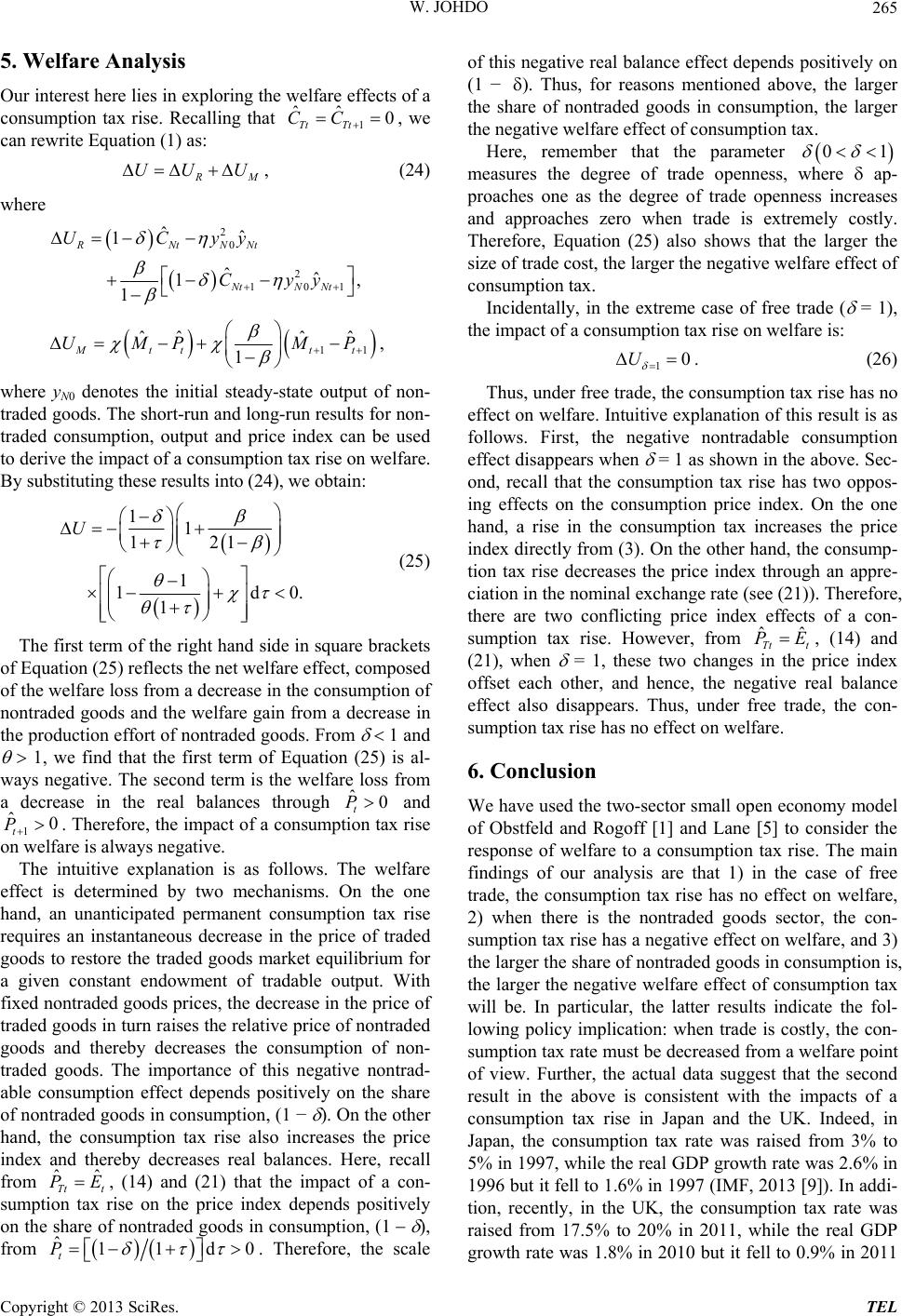
W. JOHDO 265
5. Welfare Analysis
Our interest here lies in exploring the welfare effects of a
consumption tax rise. Recalling that , we
can rewrite Equation (1) as:
1
ˆˆ 0
Tt Tt
CC
M
UU U , (24)
where
2
0
2
101
ˆˆ
1
ˆˆ
1
1
RNtNNt
NtN Nt
UCyy
Cyy
,
11
ˆˆˆˆ
1
Mtt t
UMP MP
t
,
where yN0 denotes the initial steady-state output of non-
traded goods. The short-run and long-run results for non-
traded consumption, output and price index can be used
to derive the impact of a consumption tax rise on welfare.
By substituting these results into (24), we obtain:
11
121
1
1d
1
U
0.
(25)
The first term of the right hand side in square brackets
of Equation (25) reflects the net welfare effect, composed
of the welfare loss from a decrease in the consumption of
nontraded goods and the welfare gain from a decrease in
the production effort of nontraded goods. From
and
, we find that the first term of Equation (25) is al-
ways negative. The second term is the welfare loss from
a decrease in the real balances through and
1. Therefore, the impact of a consumption tax rise
on welfare is always negative.
ˆ0
t
P
ˆ0
t
P
The intuitive explanation is as follows. The welfare
effect is determined by two mechanisms. On the one
hand, an unanticipated permanent consumption tax rise
requires an instantaneous decrease in the price of traded
goods to restore the traded goods market equilibrium for
a given constant endowment of tradable output. With
fixed nontraded goods prices, the decrease in the price of
traded goods in turn raises the relative price of nontraded
goods and thereby decreases the consumption of non-
traded goods. The importance of this negative nontrad-
able consumption effect depends positively on the share
of nontraded goods in consumption, ( −
). On the other
hand, the consumption tax rise also increases the price
index and thereby decreases real balances. Here, recall
from , (14) and (21) that the impact of a con-
sumption tax rise on the price index depends positively
on the share of nontraded goods in consumption, (
),
from
ˆˆ
Tt t
PE
ˆt
P11
d0
. Therefore, the scale
of this negative real balance effect depends positively on
( − ). Thus, for reasons mentioned above, the larger
the share of nontraded goods in consumption, the larger
the negative welfare effect of consumption tax.
Here, remember that the parameter
01
measures the degree of trade openness, where ap-
proaches one as the degree of trade openness increases
and approaches zero when trade is extremely costly.
Therefore, Equation (25) also shows that the larger the
size of trade cost, the larger the negative welfare effect of
consumption tax.
Incidentally, in the extreme case of free trade
= 1,
the impact of a consumption tax rise on welfare is:
10U
. (26)
Thus, under free trade, the consumption tax rise has no
effect on welfare. Intuitive explanation of this result is as
follows. First, the negative nontradable consumption
effect disappears when
= 1 as shown in the above. Sec-
ond, recall that the consumption tax rise has two oppos-
ing effects on the consumption price index. On the one
hand, a rise in the consumption tax increases the price
index directly from (3). On the other hand, the consump-
tion tax rise decreases the price index through an appre-
ciation in the nominal exchange rate (see (21)). Therefore,
there are two conflicting price index effects of a con-
sumption tax rise. However, from , (14) and
(21), when
= 1, these two changes in the price index
offset each other, and hence, the negative real balance
effect also disappears. Thus, under free trade, the con-
sumption tax rise has no effect on welfare.
ˆˆ
Tt t
PE
6. Conclusion
We have used the two-sector small open economy model
of Obstfeld and Rogoff [1] and Lane [5] to consider the
response of welfare to a consumption tax rise. The main
findings of our analysis are that 1) in the case of free
trade, the consumption tax rise has no effect on welfare,
2) when there is the nontraded goods sector, the con-
sumption tax rise has a negative effect on welfare, and 3)
the larger the share of nontraded goods in consumption is,
the larger the negative welfare effect of consumption tax
will be. In particular, the latter results indicate the fol-
lowing policy implication: when trade is costly, the con-
sumption tax rate must be decreased from a welfare point
of view. Further, the actual data suggest that the second
result in the above is consistent with the impacts of a
consumption tax rise in Japan and the UK. Indeed, in
Japan, the consumption tax rate was raised from 3% to
5% in 1997, while the real GDP growth rate was 2.6% in
1996 but it fell to 1.6% in 1997 (IMF, 2013 [9]). In addi-
tion, recently, in the UK, the consumption tax rate was
raised from 17.5% to 20% in 2011, while the real GDP
growth rate was 1.8% in 2010 but it fell to 0.9% in 2011
Copyright © 2013 SciRes. TEL